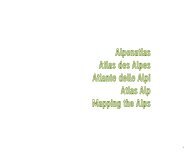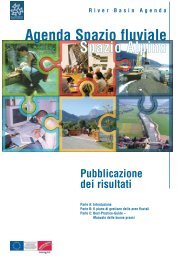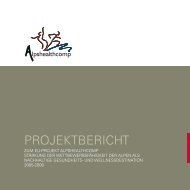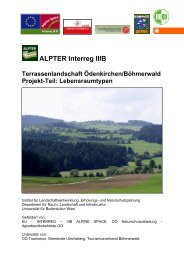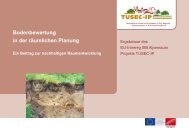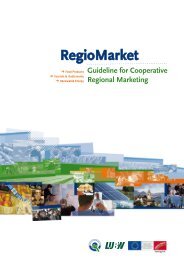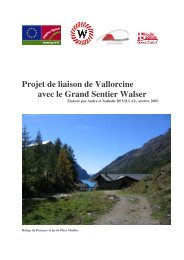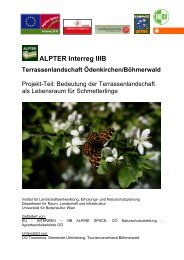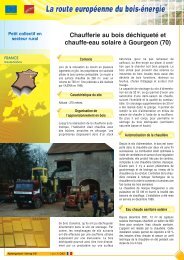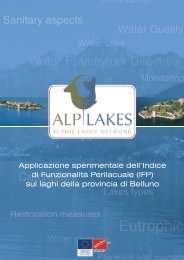WALSERSPRACHE - The four main objectives of the Alpine Space ...
WALSERSPRACHE - The four main objectives of the Alpine Space ...
WALSERSPRACHE - The four main objectives of the Alpine Space ...
Create successful ePaper yourself
Turn your PDF publications into a flip-book with our unique Google optimized e-Paper software.
LA PERIFRASI CON “FARE” NEL DIALETTO WALSER DI GRESSONEY<br />
in <strong>the</strong> present indicative. <strong>The</strong> auxiliary “tue” merely helps conjugate <strong>the</strong> <strong>main</strong> verb. It has<br />
no semantic function whatsoever. To fur<strong>the</strong>r peruse this matter I devised a number <strong>of</strong> sentences<br />
in Italian which were <strong>the</strong>n translated and discussed with native Walser speakers,<br />
alongside with a number <strong>of</strong> sentences in Titsch which make up an acceptability test. <strong>The</strong><br />
purpose <strong>of</strong> this test was to confirm <strong>the</strong> trends emerging from translation data. I ga<strong>the</strong>red<br />
this data recording with a visible tape-recorder <strong>the</strong> translations supplied by <strong>the</strong> informants<br />
after <strong>the</strong>y had read <strong>the</strong> Italian text. As for <strong>the</strong> elaboration <strong>of</strong> <strong>the</strong> data thus obtained,<br />
I annotated <strong>the</strong> sentences I obtained in Titsch with <strong>the</strong> help <strong>of</strong> a native speaker. Sentence<br />
structures where <strong>the</strong> auxiliary “to do” is used in combination with <strong>the</strong> infinitive <strong>of</strong> <strong>the</strong><br />
<strong>main</strong> verb are not exclusive to <strong>the</strong> Gressoney dialect, nor are <strong>the</strong>y to be found solely in<br />
Walser dialects in North-western Italy. <strong>The</strong>y are quite widespread in many German and<br />
English dialects, as well as in o<strong>the</strong>r languages <strong>of</strong> <strong>the</strong> Germanic family. <strong>The</strong>se sentence<br />
structures however may take on diverse tasks, which says a lot about <strong>the</strong> great versatility<br />
<strong>of</strong> <strong>the</strong> verb “to do”. It can codify a verb’s time and mode, underscore clause subordination,<br />
form a causative clause or assert pragmatic statements. Taking as a starting point<br />
a study on periphrastic sentence structure in <strong>the</strong> dialect <strong>of</strong> Formazza (Dal Negro), I<br />
accordingly designed my questionnaire for Gressoney. Considering trends emerging from<br />
Dal Negro and o<strong>the</strong>r studies on Gressoney’s dialect (Zürrer), I focussed on <strong>four</strong> specific<br />
points: 1) present indicative, 2) imperative, 3) subjunctive I and 4) subjunctive II. Both<br />
<strong>the</strong> perfect tense and o<strong>the</strong>r periphrastic structures were only marginally considered, since<br />
in o<strong>the</strong>r German dialects <strong>the</strong>y have not <strong>the</strong> auxiliary “to do”. A similar pattern was<br />
expected to surface in our dialect, as it was indeed confirmed by ga<strong>the</strong>red data (for a<br />
more in-depth study Cfr. Angster 2006). <strong>The</strong> causative use <strong>of</strong> <strong>the</strong> auxiliary “tue” was also<br />
probed. Most <strong>of</strong> <strong>the</strong> data was ga<strong>the</strong>red from <strong>the</strong> use <strong>of</strong> <strong>the</strong> present tense, whereby links<br />
among <strong>the</strong> use <strong>of</strong> <strong>the</strong> present, <strong>the</strong> verbs’ action classes, <strong>the</strong> auxiliaries and <strong>the</strong> “kurzverben”<br />
were analysed. Data ga<strong>the</strong>red on <strong>the</strong> use <strong>of</strong> <strong>the</strong> subjunctive confirm <strong>the</strong> trends as<br />
per WKZ 1988a. To clarify <strong>the</strong> employment <strong>of</strong> imperative periphrastic forms I checked data<br />
on <strong>the</strong> imperative against those on <strong>the</strong> indicative. Finally, <strong>the</strong> periphrastic use <strong>of</strong> “to do” in<br />
structured sentences was that <strong>of</strong> “tunz” plus infinitive. Analysing <strong>the</strong> data ga<strong>the</strong>red by<br />
submitting <strong>the</strong> questionnaire to <strong>four</strong> native speakers I obtained <strong>the</strong> following: 1) auxiliaries<br />
“to be” and “to have”, as well as modal verbs, cannot be supported by “tue”, ei<strong>the</strong>r<br />
as auxiliaries or <strong>main</strong> verbs. Some verbs may be used independently, although <strong>the</strong>ir use<br />
with “tue” is also recurrent. A wider gap <strong>of</strong> indecisiveness occurs with “Kurzverben”.<br />
90



